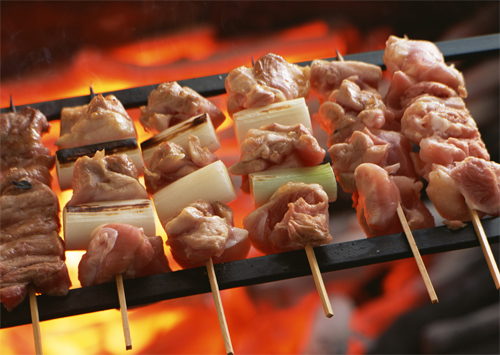Yakitori is grilled skewered chicken dipped in a Teriyaki-like sauce. It is a very popular appetizer at Yakitori bars and other bar-type restaurants in Japan.
Yakitori could be a dish at your dinner table, but it is more like the food you eat with drinks at bars. A lot of Yakitori bars grill their chicken on a charcoal grill, and the tasty smells of grilled meat and smoke come out to the street to attract customers. People in Japan like to go out to drink after work, and Yakitori bars are one of the most popular places to have a drink.
Yakitori bars serve very basic type of Yakitori like ours, but also there are a wide variety of skewered items there. They use every part of a chicken for Yakitori. They not only use chicken breast and thighs, but skin, cartilage, hearts and … well, everything else. Yakitori is often eaten with Tare (thick sweetened soy sauce), but simple Shio (salt) seasoned Yakitori is also very popular.
If you live in Japan and would like Yakitori at home for dinner, you may certainly make it; however, you can also easily get it at many places there. Chicken butcher shops often have Yakitori to-go that is grilled right at a little corner of the shop. Supermarket delis also have Yakitori on-the-go just like roasted and fried chicken at supermarkets in the US. If that’s even too much trouble :-), you can stock up with canned Yakitori (not skewered) to satisfy your spontaneous Yakitori cravings.
Yakitori Recipe
Shio (salt)
Many of us live outside Japan but would like to eat Yakitori from time to time…. Make Yakitori on a barbeque grill if you can; that’s the best. Charcoal grill especially gives it a wonderful flavor. When you think It is a little too much work to start a fire for a weekday dinner or anytime at all, you’re in luck, we made a recipe using a frying pan. It is so easy to make!
We have 2 flavorings for Yakitori here: Shio (salt) and Tare (sauce). We like both, and hope you do too! Just make sure your beer is super cold before you finish making it.
Yakitori Recipe
Prep Time: 25 minutes
Cook Time: 15 minutes
Yield: 9-10 skewers
Ingredients :
1/2 cup soy sauce (120ml)
1/4 cup sugar (50g)
1/4 cup Sake (60ml)
1/4 cup Mirin (60ml)
1 lb chicken thighs (450g)
2 long white onions (or 5-6 green onions)
salt
vegetable oil
Instructions :
Soak bamboo skewers (6" long) in water for 30 minutes.
Mix soy sauce, sugar, Sake, and Mirin in a small pot, and boil for 8-10 minutes until the sauce gets a little thick. Set aside.
Cut chicken thighs into 1" cubes, and cut onions (white part) into 1" long pieces. Skewer chicken and onions alternately.
In a heated frying pan, spread oil very thinly, and cook skewered meat at medium high heat for 5 minutes. Turn and cook another 5 minutes until browned and cooked through.
Immediately dip chicken in the sauce, and serve.
Yakitori with salt
For Yakitori with salt, skewer just chicken pieces and sprinkle with salt. Cook in the same way as Yakitori with sauce (but don't dip in sauce).












